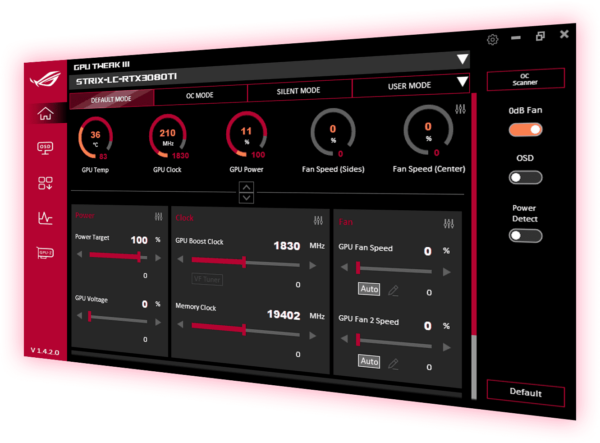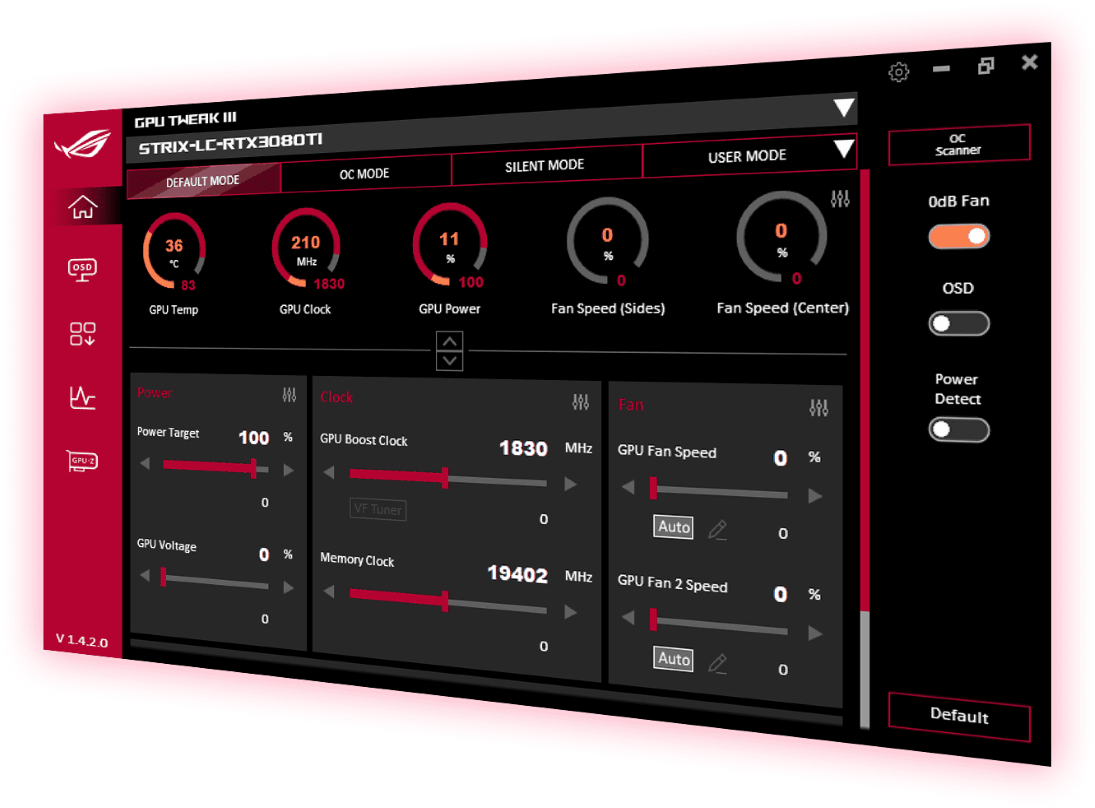Revamped graphics-card tuning and monitoring software is more intuitive and feature-rich than ever before
Revamped graphics-card tuning and monitoring software is more intuitive and feature-rich than ever before
Ratingen, Germany, June 02, 2022 — ASUS today announced the official launch of GPU Tweak III, an overhauled version of the free utility for enhanced tuning and monitoring of AMD and NVIDIA® graphics cards, including those from the ASUS Dual, TUF Gaming, and ROG Strix gaming lines. After an intense year-long beta process, the app has been gradually reworked and enhanced to improve its core performance and bring new features to make it more approachable for beginners and more streamlined for overclocking veterans.

Reworked software; reworked process
When opening the program, users will be greeted with immediate changes, as the interface has been completely revamped from the GPU Tweak II era. Instead of dividing functionality between simple and advanced modes, all of the most important tuning and fan control options are readily available on the Home screen, so that new recruits and tuning aficionados can jump right into the action. In recent patches, the user interface has been further streamlined with slick icon-based navigation tabs on the side, and now also offers additional perks for select ROG Strix graphics cards, such as input voltage detection toggling and control over external fans tethered to FanConnect II headers.
Behind the curtain, there were also process-based improvements during that beta period that might be invisible to the casual observer. In order to improve transparency and deeper understanding with the community, ASUS built a support mechanism via the GPU Tweak III website for direct-to-developer feedback. With suggestions flowing through both there and a temporary beta channel in the Republic of Gamers Official Discord, users were able to help the developers identify many places to make performance and stability enhancements, and even suggest new features.
User-requested changes
Some of the often-requested features were already in the works. Monitor graphs for FPS and frame-time measurements were two of the hottest items on the development list, and were just unveiled with the launch release. Additionally, multi-language support was in the original design and now the latest patch is fully translated into German, French, Turkish, Korean, and Chinese (both Traditional and Simplified characters). More languages will be added in the future.
But many suggestions from users caused the dev team to re-evaluate their plans and shift focus to the needs of the community. Early into development, enthusiast feedback led to the creation of a log viewer for the Monitor so that users can cross-reference previous tuning sessions. Later on, beginners requested help documentation, so GPU Tweak III is launching with a set of tutorial videos to understand the major software functions. However, the biggest change, and the one that required the most development time, was an overhaul to one of the core overclocking functions: the VF Tuner.
A new take on voltage-frequency curve editing
GPU Tweak II had a simple Voltage-Frequency Tuner that had been imported into GPU Tweak III, but as more users have become accustomed to manually tuning their graphics cards, it had become clear that a more intuitive overclocking curve adjustment system was necessary. So ASUS took every aspect of VF tuning to the drawing board, and made a first-of-its-kind interface that combines WASD and arrow keyboard controls with a toolbar reminiscent of common graphic-design software.
Both systems are clearly displayed with helpful control tips and an expandable command list, so users do not need to check outside of the software for what kinds of functions are available. Among the built-in features are multi-point movement, curve rotation, and linear alignment. Users can also lock GPU voltage and frequency at any point along the curve in order to test stability. To further help the process, different curves are automatically saved into the system, so users can fall back to a previous save point if they push the system too far.
Fan controls complement a tuned GPU
Optimization does not end at power and clock speed enhancements. A suite of sliders and toggles enable users to manually tune graphics card fan speed, including an option for 0 dB Fan mode. If a higher level of control is desired, custom fan curves can be set and saved. New to GPU Tweak III are temperature hysteresis and update period settings that can also be modified to adjust how quickly fans respond to thermal changes. All of these functions extend to chassis fans that are connected to FanConnect II headers featured on select ROG graphics cards.
Never miss a detail with the OSD
To keep an eye on GPU, fan, or any other performance stats, GPU Tweak III’s on-screen display (OSD) allows system information to be displayed while other applications are in use. In addition to the metrics to be monitored, users can customize the overall style, font, opacity, size, position, and more. A built-in preview function helps users quickly check how their OSD looks without opening a game or program. Designs can be saved in a similar fashion to tuning profiles, making it simple to switch layouts and monitoring data based on the task at hand.
Automatic profile swapping
Links between user-created profiles and any specific game or software can be made using Profile Connect, a feature that first debuted on the beta version of GPU Tweak III. Installed applications are selected and linked to tuning and OSD profiles via drop down menus and buttons. Once linked, chosen settings will automatically load up whenever the target program begins running. This is a compelling feature for users that work and play on the same system. Without any additional input, low acoustic levels can be prioritized for creative workflows while dedicated high-performance settings can be loaded for max FPS in any game.
Celebration giveaway
To commemorate the official launch of GPU Tweak III, ASUS is giving away a whole host of gaming components. For the top prize, an ROG Strix LC GeForce RTX 3090 Ti accompanied with an ROG Thor 1000W Platinum II and ROG graphics card holder is up for grabs. Second through fifth-place prizes also include ROG and TUF Gaming graphics cards and power supplies.
From June 6 through to June 27, users who complete the questionnaire on the campaign page will be eligible for a main prize, while those who test out GPU Tweak III and provide feedback are qualified to win their choice of any ROG graphics card holder. ASUS will choose the winners based on the overall best answers given by participants.
Availability
To download the new GPU Tweak and get more detailed information on all of its many features, please visit the landing page.
About ASUS
ASUS is a global technology leader that provides the world’s most innovative and intuitive devices, components and solutions to deliver incredible experiences that enhance the lives of people everywhere. With its team of 5,000 in-house R&D experts, ASUS is world-renowned for continuously reimagining today’s technologies for tomorrow, garners more than 11 awards every day for quality, innovation and design, and is ranked among Fortune’s World’s Most Admired Companies.


